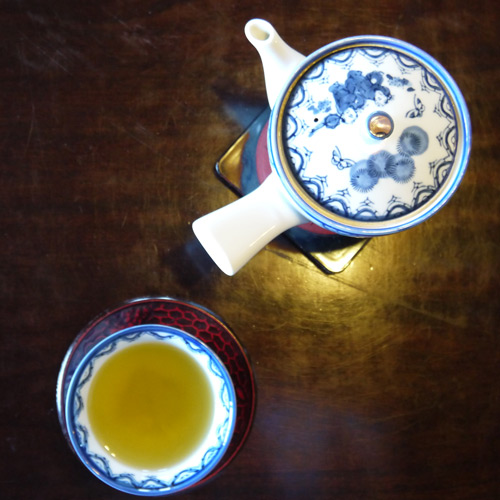Green Tea: Everything You Need To Know

History
Green tea was first discovered by accident in 2737BC by Emperor Shen Nong; while boiling a pot of water in his garden tea leaves happened to land in the pot, infusing it and creating the world’s first pot of tea. After the Emperor drank the tea he was immediately impressed with the drink and quickly tea drinking spread throughout the kingdom.
It wasn’t until the early 9th century that Buddhist monks returning to Japan brought green tea with them and started a tea trading channel between the two countries. In the later part of the 12th century a priest, returning from China, bought with him tea plant seeds and establishing Japans first tea gardens near Kyoto which lead to a rise in the drinks popularity outside of the priesthood.
Types of Green Tea

There are too many different methods for growing, processing, roasting and blending green tea to list here so we’ve just listed the most common. Sencha is the most well-known and most frequently consumed form of Green tea grown. Plants are grown in full sun and both the first and second flush (harvest) are used with the leaves being prepared in the traditional manor; first steamed and then rolled. Bancha is generally considered to be a lower quality form of Sencha made from the off season harvests between summer and autumn but otherwise prepared in much the same way.
Gyokuro is a finer leaf variety compared to Sencha as it is grown in full shade for the three weeks prior to the harvest. These difficult growing conditions cause an increase in the amino acids and a decrease in the overall caffeine content and the overall bitterness of the tea.
Matcha is a finely ground tea powder which like Gyokuro comes from plants grown in shade. Matcha can be substantially more expensive than most green teas and is used almost exclusively for Japanese tea ceremonies as well as being flavouring in ice cream and other sweets.
Genmaicha is something of an oddity; a combination of Bancha or Sencha tea leaves blended with cooked brown rice that has been roasted and ‘popped’. Genmaicha produces a unique taste due to the combination of the savoury brown rice taste and the refreshing green tea flavour.
H?jicha is prepared by roasting leaves over charcoal instead of steaming them. This results in a copper colour to the leaves and a sweet taste. Due to the temperature the tea is roasted at most of the caffeine content is removed from the leaves.
Gunpowder is most notable for its general resemblance to tiny pellets of gunpowder. When brewed the leaves uncurl and expand to at least twice their size meaning only a small quantity of leaves are required to prepare a cup.
Zen Sencha Tokyo Sencha Green Darjeeling Green Apple Pie Serendipity
Health Benefits
Weight Loss
Fundamentally body weight is governed by the quantity of food eaten, the body’s ability to convert and store energy from that food and then the speed at which that energy is expended. The antioxidant polyphenol found in green tea intensifies the speed with which your body can process food and convert it to calories ready for use. This doesn’t mean drinking green tea will cause you to lose weight on its own however it will increase the body’s metabolic rate allowing for faster weight loss when combined with a sensible diet and exercise plan.
Depression
When we think of the benefits of green tea it’s easy to just focus on the physical but there is a growing body of evidence that the amino acid theanine found in green tea leaves has a mild tranquilizing effect on the mind reducing stress and anxiety and stimulating dopamine levels in the brain.
Mental depression is a disease that should be medically treated by a therapist however green tea can contribute to the well-being of those who are feeling down.
Tooth Decay and Bad Breath
Green tea is a natural source of fluoride and in combination with its anti-bacterial effects it provides a natural way to strengthen teeth which in turn prevent cavities and tooth decay from forming and regularly drinking green tea has been shown to control periodontal gum disease and stop gum bleeding. In addition the polyphenols in green tea destroy many of the compounds found in the mouth which cause bad breath and can even help after eating garlic.
Blood Sugar and Diabetes
Type 2 diabetes is caused by a combination of high blood sugar levels in the body and low levels of production and absorption of insulin within the pancreas. Drinking green tea can help with this as the catechins, flavonoid antioxidants, found in green tea can aid in reducing blood sugar and overall improve sensitivity to naturally produced insulin.
Heart Disease and High Blood Pressure
High blood pressure or hypertension is the most prevalent form of heart disease affecting adults. High blood pressure can lead to kidney problems, heart failure, stroke and a primary risk factor in heart-related death.
Blood pressure is the force exerted on your arteries as a result of blood being pumped throughout the body. Green tea antioxidants relax blood vessels allowing them to move through the body far easier and protect against blood clots forming. Drinking at least one cup of green tea daily reduces the long-term chances of developing hypertension and reduces high blood pressure by as much as half.
Cholesterol
Drinking several cups of green tea each day reduces the absorption rate of bad cholesterol (LDL) and improves the absorption of good cholesterol into the digestive system and speeds up the process by which it is expelled from the body. In addition green tea helps prevent the cholesterol that is absorbed into the body from being converted into the more dangerous oxidized LDL. Further, the flavonols found in green tea can assist in naturally thinning the blood which helps to reduce the hardening of the arteries. The reduction in bad cholesterol and hardening of the arteries reduce the long term likelihood of cardiovascular diseases such as heart attack or stroke.
Rheumatoid Arthritis
Rheumatoid arthritis is a progressive autoimmune disease that can result in brief but intense inflammation within some sufferers. The polyphenol antioxidants found within green tea can, over time, alleviate the frequency and severity of pain occurring within arthritis sufferers. Regularly drinking green tea can delay and reduce the long term probability of developing arthritis.
Alzheimer’s and Parkinson’s
Not only can green tea improve brain function in the short term, it may also protect your brain in old age. Alzheimer’s disease is the most common neurodegenerative disease in humans and a leading cause of dementia. Parkinson’s disease is the second most common neurodegenerative disease and involves the death of dopamine producing neurons in the brain. Multiple studies show that the catechin compounds in green tea can have various protective effects on neurons in test tubes and animal models, potentially lowering the risk of Alzheimer’s and Parkinson’s.
Skincare and Acne
One of the latest benefits of green tea is the effect it has on your skin and the aging process. It is again down to the antioxidants that prevent cell oxidation and damage that can make you look older than you really are. Studies are mixed on this particular green tea benefit as new research has come to light which suggests the full benefits can only be had by applying green tea topically to your skin. However, many people have found that potent green tea extracts do have a positive effect on their skin, leaving it softer, more supply and younger looking.
Cancer
Cancer is caused by uncontrolled growth and reproduction of cells which have been damaged by free radicals, incomplete molecules which attack cells in order to obtain missing electrons. Antioxidants neutralise free radicals and green tea is an excellent source of powerful antioxidants called catechins, so drinking can green tea can reduce the long term risks of many types of cancer developing.
Just a note: adding milk to tea negatively reduces the antioxidant intake from green tea.
Breast cancer studies have found that women who drank several cups of green tea per day had a 22% lower risk of developing breast cancer.
Prostate cancer studies have observed that men who drink green tea have up to a 50% lower chance of developing prostate cancer, the most common form of cancer in men.
Lung cancer risks in smokers can be greatly reduced by drinking green tea with some studies suggesting up to a two thirds reduction.
Colon or bowel cancer risks are reduced by more than 50% for regular drinkers of green tea according to a comprehensive study carried out in China.
Further studies are currently being carried out with promising results for reducing the risk of developing Leukaemia as well as Pancreatic, Bladder and Ovarian Cancer
Many studies have further demonstrated that regularly drinking green tea can also reduce the chances of recurrent cancer developing.
Final Words
Despite all of these benefits there are a couple of drawbacks to green tea; green tea does contain tannins which can negatively impact the body’s ability to absorb iron and folic acid which could be a problem for anyone currently suffering from anaemia and green tea does contain caffeine which, if you are trying to eliminate caffeine from your diet is a problem although there are low caffeine forms of green tea available.
Plainly there are many benefits to drinking green tea so the question remains just how much do you need to drink in order to receive these benefits? Well many of the studies we looked at came from Japan or China where drinking green tea is a way of life and many had participants who drank six cups a day however many other studies suggested that just two cups of a day is all you need.




